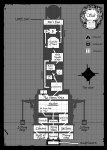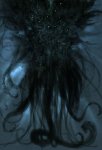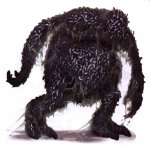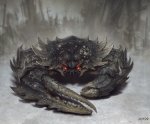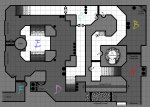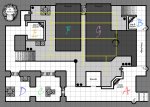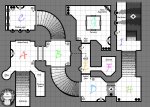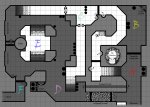Session 2 has concluded
This week the group finished the battle that we started 2 weeks prior. They were in the middle of a big boss battle, and kind of on the ropes. But this week they returned with renewed courage, and with plans. The players had been discussing tactics all week, and also in the car on their way to my house. So now they were prepared to turn the tables, and start working more as a group. They were no longer feeling a little desperate... they were going to win this!
Much to my surprise, one of the players tried to
reactivate the Oarsmen runes in the room. This was an option I had not considered. Most of the runes had been smashed already by the villains, but I figured such an original idea should not go unrewarded. So I ruled that the runes partially lit up, and would impose a penalty on the attacks of Hydra servants now. But it would take a professional runesmith to restore the magical runes completely.
The players used a clever combination of spells, to block the entry that reinforcements were pouring through. First they got some of their npc allies out of there, and then used a Control Water spell, in combination with a cold spell, to
block the entrance with frozen ice. This allowed them to focus on the boss, instead of the minions. Plus because some of the water had been moved, part of the room was now dry. This allowed their summoned Fire Elemental to cross over to the other side of the room and attack the boss. This is the first time I've seen them use spell combos like that. I now see that it was good to push them to their limits so much. Desperate situations demand desperate (and clever) plans. Because of this blockade, the avatar could now not retreat, which was very decisive.
The players were able to finish off the avatar, with the help of their Fire Elementals. The avatar was unable to escape, and they focused fire on her to get through her damage reduction and regeneration. As the avatar caught fire, it made one last attempt to dive into the water to extinguish the flames, but an attack of opportunity from a Fire Elemental finished her off.
In the avatar's mind
Meanwhile an interesting roleplaying situation emerged. I ruled that since one of the players (an elf named
Bioran) was still in a mindlink with the dying avatar,
his conscience would still be trapped in her mind as she was dying. The player wanted to try and find the soul of their elven friend, that would surely still be in the avatar's body somewhere. So I ruled he had to take a
search action to search her mind (how's that for a clever use of that skill?). Bioran succeeded in finding her, and I described it as if he was in a pitch black room, where he could only see the elf that the avatar had taken over. She was wrapped in goo, as if cocooned, unable to move. But meanwhile he could feel that the room was getting smaller, as life slipped away from her body. He would have to succeed at a
willpower (wisdom) check to free her. His goal was to try and take her soul with him, but he did poorly on the check, and so he could feel her starting to be lifted upward. With her last gasps she warned him that
"they had to hurry, because Hydra was about to breach the gates of the tower, because the builder never finished the harbor's defenses. They could not let Salt fall into the hands of the enemy..."
It was at this point that another party member,
Che, the priest of the group, decided that he would try and get Bioran to wake up. Because he didn't know what Bioran was trying to do, and only saw Bioran collapse on the ground as the avatar died. He believed Bioran's conscience could end up trapped in the avatar's body if he didn't bring him back fast, and he wasn't wrong.
I thought to myself that this would be the perfect moment for a cinematic moment. Just as the priest started to pull Bioran out of the avatar's mind, I had the elven lady say:
"...There is one more very important thing I need to tell you...", and that is when I had them roll opposing willpower (wisdom checks), with advantage for the priest. The priest won, and yoinked him back into his own body before she could finish her sentence.
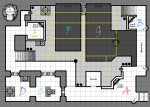 Part 3 - stopping the invasion
Part 3 - stopping the invasion
The big boss battle was over, but they still had a second big battle to deal with in the final third area of the dungeon. A lot of this battle was balanced around the idea that the boss could have fled into this final part of the room... but she didn't. I decided to still give them a fair number of enemies to deal with, plus two new enemies they hadn't seen before: Siege Crabs and Avolakia. The latter are large upright worm like creatures, with many tentacles, many attacks, and the ability to polymorph into the shape of any human, and use mind affecting singing to influence enemies. This was an enemy I had as a backup, incase the other enemies were starting to feel repetitive.
I had one of the Avolakia shapeshift into the avatar of Teehlyian'tara, which gave the players a big scare! But they succeeded in recognizing that it was merely a polymorph spell. Still, the singing of the Avolakia succeeded in persuating some npc allies in coming to her aid, and help with opening valve
B.
The players were quick to close off the floodgate
G. But the Avolakia would later manage to open it again at
B (and with the help of some hypnotized npc's), there by letting a second Siege Crab in. The players had underestimated how short it would take the next Siege Crab to enter. The floodgate was opened in one round, and the Siege Crab entered in the next, which is not unreasonable I think.
The players were able to use the Ring of the Ram (here we go again!) to knock one of the valve handles off at
E, to prevent another Avolakia from opening floodgate
F.
The players understood immediately that the
crane controls at
A could be used to grapple one of the crabs, and they loved it. It took them a few attempts, but they finally got it, just as the second Siege Crab entered. Just in time! With one Siege Crab grappled by the crane, they now had only one crab to deal with, instead of two. They quickly closed floodgate
G again, to prevent further reinforcements.
The players discovered the cannon, rifles and gunpowder in warehouses
C and
D a bit late in the fight. But they used a barrel of gunpowder at the end to kill off multiple enemies at once, and also collapse part of the harbor in the process.
The players even used the elevator to lower one of their Huge Fire Elementals down.
The players used the various balconies for cover, although none of the enemies had ranged attacks. This may have been a mistake on my part in hind sight.
The players exploited the moment where one of the Siege Crabs opened its armor to unload a passenger, to score lots of hits on it. Because opening the armor lowers its armor class temporarely, until it closes again.
The players made a lot of use of summoned creatures to deal with the big threats in these battles. Lots of use of beefy fire and earth elementals.
One player had to retreat, or he would have been killed. The Siege Crab did massive damage to him, and could have grappled him and killed him, if it weren't for Freedom of Movement. It is good when the players know when to retreat.
In conclusion
I got an applause from my players for such a thrilling and intense battle! (never had that before) This was just the sort of prolonged battle that they were longing for, which drained their resources, and really threw them on the ropes. All of the PC's had sustained big injuries, and one came close to being dropped to 0 HP, if it weren't for a quick retreat.
I ended the campaign by describing how they finished off the Siege Crab that was grappled by the crane, with the cannon, and then emerged victoriously up above. But as they gazed over the water outside the tower of Salt, they now saw a massive enemy fleet had surrounded the royal navy of St Valenz. The silhouettes of several of Hydra's Living Ships could be seen underneath the surface of the water, and the flagships of their arch enemies, the Circle of Azarah, could be seen in full view. They had survived a huge land battle, but the biggest naval battle was about to begin.
The players went home very excited, full of plans on how to deal with this new threat for our next session. They were already discussing all their intended actions as they were heading for the car. And they probably spent the rest of the evening discussing all the highlights of the evening, of which there were many. Surprisingly some of the best roleplaying moments (such as with activating the runes, and entering the mind of the avatar) were completely improvised on the spot.
Evaluation of the enemies
I'm also very happy with my choice of enemies for this session. The
Leechwalkers were simple and beefy, with some good damage potential, lots of HP, yet easily tanked. Their Wounding attacks were especially potent, if they manage to hit. A good enemy to spam in groups.
The
Bloater was a very good variant, that allowed me to push some damage through all their protective spells, and force them to think about where and when to fight the thing. I could have the Bloater rush into a group of players and explode, thus forcing them to spread out more.
The
Swarm spitting Leechwalkers were scary to the players, even though the swarms themselves are not as dangerous as they believed them to be.
Avolakia can do a lot of damage to low armored players (they have 9 attacks), but their spell-like abilities were way too weak to be any serious threat to the players. Their polymorph ability did make for some funny roleplaying situations though. In hindsight, their attacks were way too weak to hit most of the PC's, so they were only ever a threat to the npc's. I think I didn't use them to their full potential here, but they were welcome variety in this final battle.
The
Siege Crab is a fantastic enemy for a big boss battle. It has insanely high armor, that makes it very difficult to hit with conventional weapons, and it has a huge reach. Its grapple attacks would have been more effective if the players didn't all have Freedom of Movement, but at least I got to use its Trample ability. The Siege Crab would have been a much tougher opponent in a wide open space, rather than one like this, that is specifically designed to offer lots of spots that are easily defended, with lots of higher ground.
Evaluation of the final part of the dungeon
Every corner of this final map was used. Mainly because of the objectives (the valves that operate the floodgates) on either side of the room, forcing the players to spread out, and cover multiple sides of the room. I think a lot of lessons can be learned from this for future battles. You need to motivate the players to move to multiple sides of the room, and you really need to think hard about all the angles of attack of your enemies. I'm glad I added the extra ladders, that allowed some of the enemies to close the gap quickly. During the final part of the battle, several players and npc's were hiding in the bottom right corner, because of the crane controls, and because of the cover position. But because of the nearby ladder, I could have a bloater quickly get up to the whole group, and punish this behavior with its AOE attack.
I really like how your gradient on the stairs communicates up/down directionality, and how you illustrate various winches/gears that open the gates. Really makes reading the map easier and more interesting!
PC might try something you hadn't anticipated (or maybe you had), and it would totally work, ruining all your hard work designing the key detour. That's simple enough; you just reward the cleverness by letting it work. Bypassing those kinds of challenges is their own reward.
